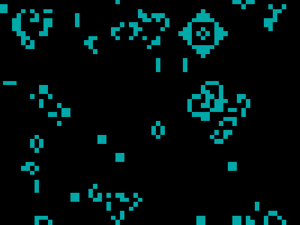 I'm going to take this blog in a rather unusual direction for the next few posts. I think you'll enjoy it.
I'm going to take this blog in a rather unusual direction for the next few posts. I think you'll enjoy it.
Many recent experiences have brought my focus to the same three titular concepts: iteration (repetition), feedback, and change. They've provoked my thoughts in an interesting way, and I hope to bring them to you in a way that will provoke your own thinking.
These three concepts seem to work together in an almost magical way to create incredible results from even the simplest beginnings. That's easy to say, but hard to understand.
The best way to understand the impressive nature of complexity developing from simplicity is to experience it for yourself. One of the best tools for this is John Conway's Game of Life, first published back in October 1970. It's not so much a game in the traditional sense, but rather a simple simulation and/or experiment with some simple rules.
Here's John Conway himself talking about the nature of the Game of Life:
Got that? Those three simple rules, for easy reference, are as follows:
Birth: An dead (empty) square with exactly three living (filled) neighbors will give birth to a new living square in the next generation.
Death: Any living square with only 1 or 0 neighbors dies from isolation, and any living square with 4 or more neighbors dies from overcrowding.
Survival: Any living square with 2 or 3 neighbors survives to the next generation.
In the videos above, you've seen some simple examples of what can happen when these 3 rules are applied, but now I want you to play around with it for yourself.
To do this, simply go to Ian McDowell's Game of Life page and play with it. Since it's not really a game, you can win or lose, so just try various things and see what happens. Detailed instructions are on the page itself.
While you're playing around with it, ask yourself what amazes you and why. The rules don't say anything about symmetry, motion, or equilibrium, but all those concepts and more develop out of 3 simple rules.
Not only can you create a piece that moves, but also a “machine” that creates these gliders, and even a meta-machine that creates these glider guns. Go back and read those 3 rules again, and note that they say nothing about being able to do any of these things! And yet, they are still possible.
If we think of groups of pixels as “creatures”, then the creatures created in this simulation are quite fascinating and thought-provoking. As noted in the essay Get A-Life (“A-Life” being shorthand for “Artificial Life”), simulation of the Sims variety is one thing, while the type of simulation discussed here is of a completely different nature.
I highly recommended reading that full essay before continuing this discussion. In it, they discuss the Game of Life, L-Plants and Biomorphs, Core Wars and Tierra, and even evolutionary programming.
In all of these things, surprising complexity, and even seemingly-impossible simplicity arise out of just the simple combination of iteration, feedback, and change.
The notion of complexity arising out of simplicity hasn't been understood as a widespread notion for very long in human history. In my next post, we'll delve into just how that happened, and the surprising effects the spread of the notion had itself.
1
Iteration, Feedback, and Change: Artificial Life
Published on Wednesday, May 25, 2011 in fun, innumeracy, math, psychology, self improvement, software, videos
Related Posts
Post Details
Posted by Pi Guy on May 25, 2011
Labels:
fun,
innumeracy,
math,
psychology,
self improvement,
software,
videos
Subscribe to:
Post Comments (Atom)




1 Response to Iteration, Feedback, and Change: Artificial Life
Thanks so much for your interesting Blog. If I had the time, I could spend hours on all of your links.
Post a Comment